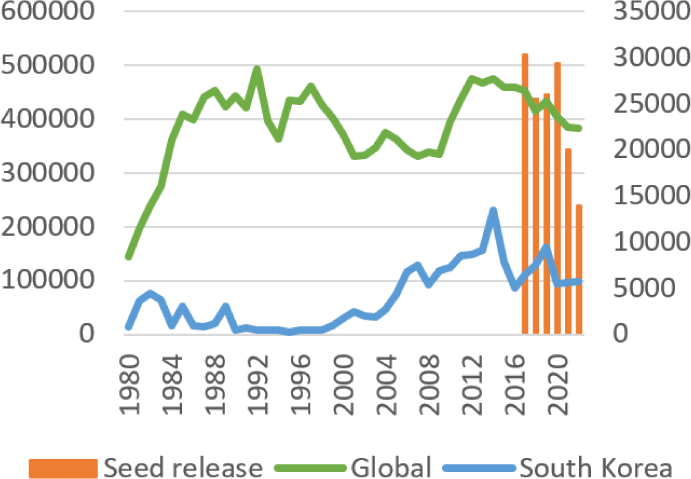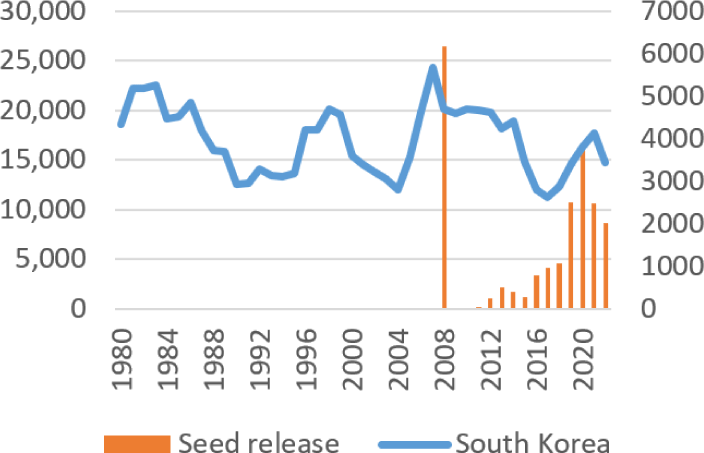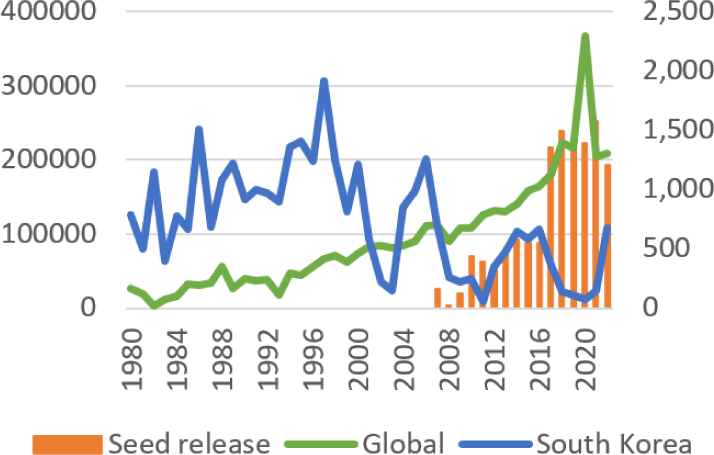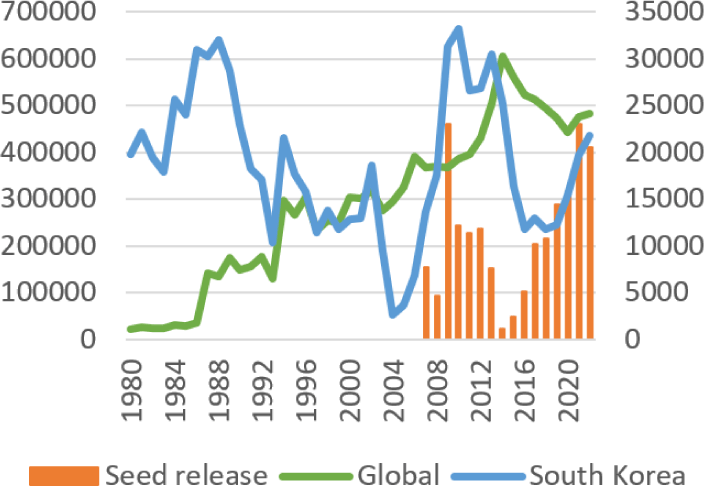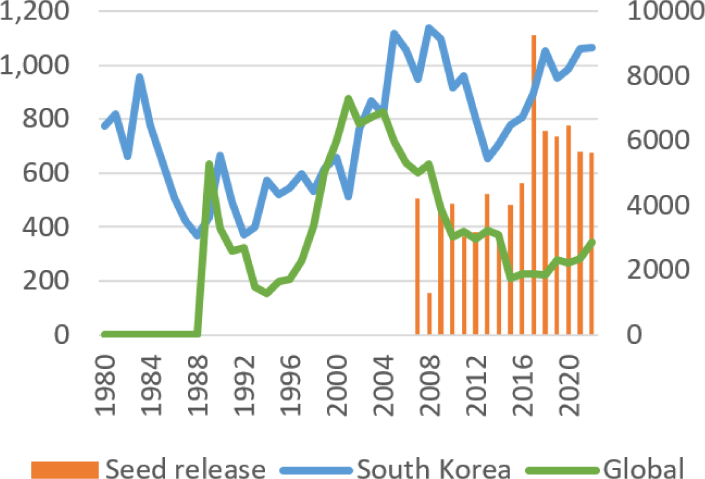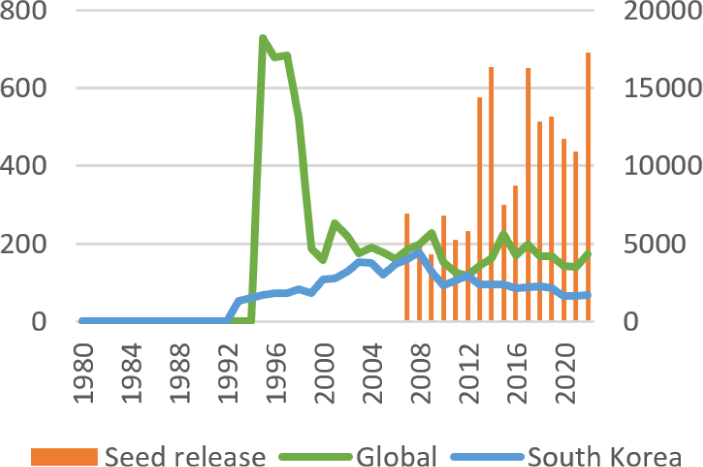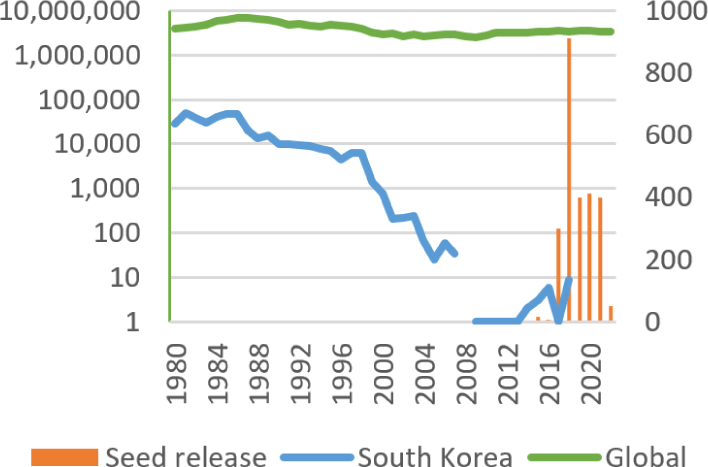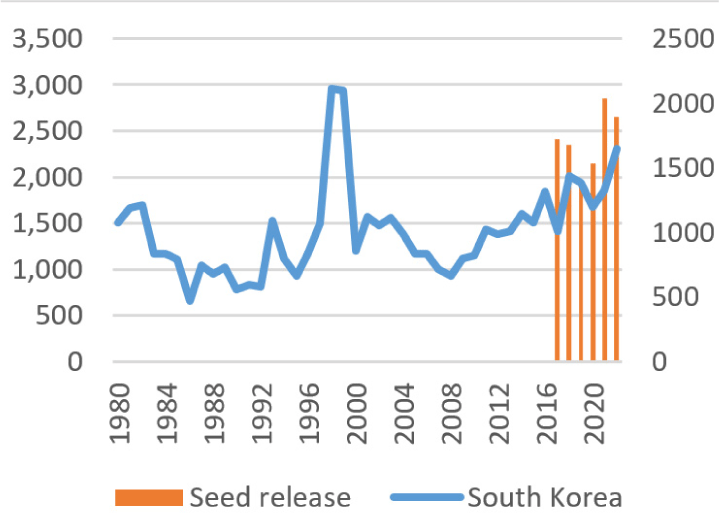1. Introduction
Climate change is affecting almost every aspect of the Earth's environment. In terms of the marine environment, it is causing an increase in ocean temperatures, sea level rise, ocean acidification, and a decrease in marine biodiversity. It is also affecting the ability of marine species to reproduce, spawn, nurture, and grow (Hoegh-Guldberg & Bruno, 2010). In the Intergovernmental Panels on Climate Change (IPCC)’s Special Report on “Global Warming of 1.5°C”, adopted in 2018, the IPCC compares the difference between limiting the global temperature increase to 1.5°C and 2.0°C above pre-industrial levels in 2100. Specifically, the report estimates that limiting temperature increase to 1.5°C could reduce the number of people at risk in coastal areas by 10 million and reduce fish catches by 1.5 million tonnes compared to a 2.0°C increase (decreasing 3 million tonnes for a 2.0°C increase and decreasing 1.5 million tonnes for a 1.5°C increase).
The effects of climate change can also be seen in Korean seas. Based on the observations of the National Institute of Fisheries Science (NIFS)'s seas survey, the average annual surface seas water temperature increase in Korean waters over the past 55 years (1968–2022) was 0.025°C/yr, an increase of about 1.36°C, while the global average surface seas water temperature increase over the same period was 0.0094°C/yr, an increase of 0.52°C. The average annual surface seas water temperature increase in Korea's nearshore waters was 0.0094°C/yr, which was 0.52°C higher than the global average.
Some studies show that rising ocean temperatures are causing many marine species to shift upward in their latitudinal distribution or to move to deeper, cooler waters (Saba et al., 2023). Of course, there are many factors that can contribute to changes in the catch of marine species, such as changes in water temperature, overfishing, reproductive collapse, changes in the food chain, and changes in habitat due to ocean acidification. But there's no denying that climate change is certainly playing a role.
Climate change is reducing fisheries production, and changing fish species (Brander, 2007; IPCC, 2018). As a result, aquaculture, which can partially control changes in the environment, is becoming increasingly important. Globally, aquaculture's share of production continues to rise. When including both ocean and inland waters, aquaculture accounted for 58.65% in 2022 (Figure 1). In 2022, aquaculture accounted for less than half of the ocean fisheries production at 42.66 % (Figure 2). There is no doubt that aquaculture will continue to grow in importance and become a vital part of food security.
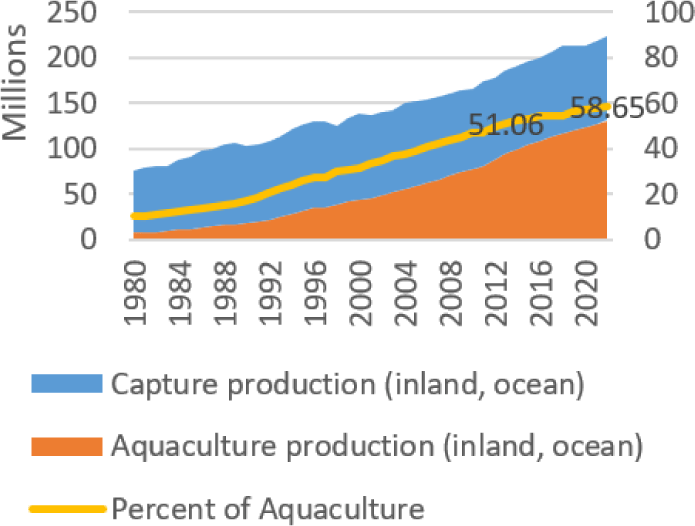
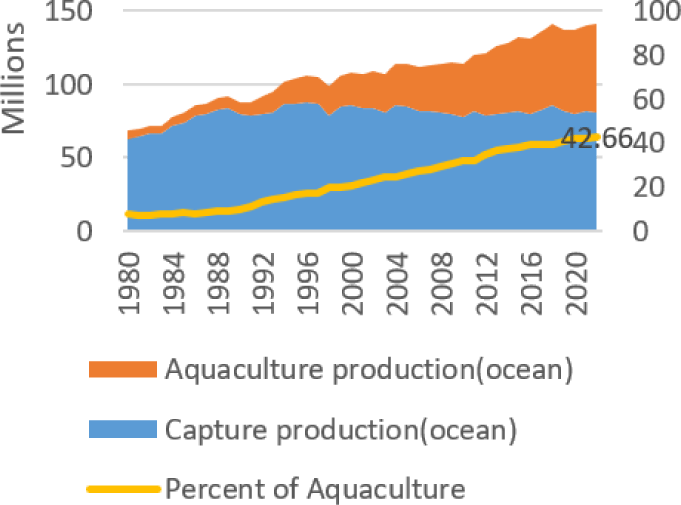
Korea's aquaculture production has grown rapidly from 119,211 tonnes in the 1970s to 2,250,567 tonnes in 2018, and aquaculture production has overtaken fisheries production in total seafood production (Figure 3).
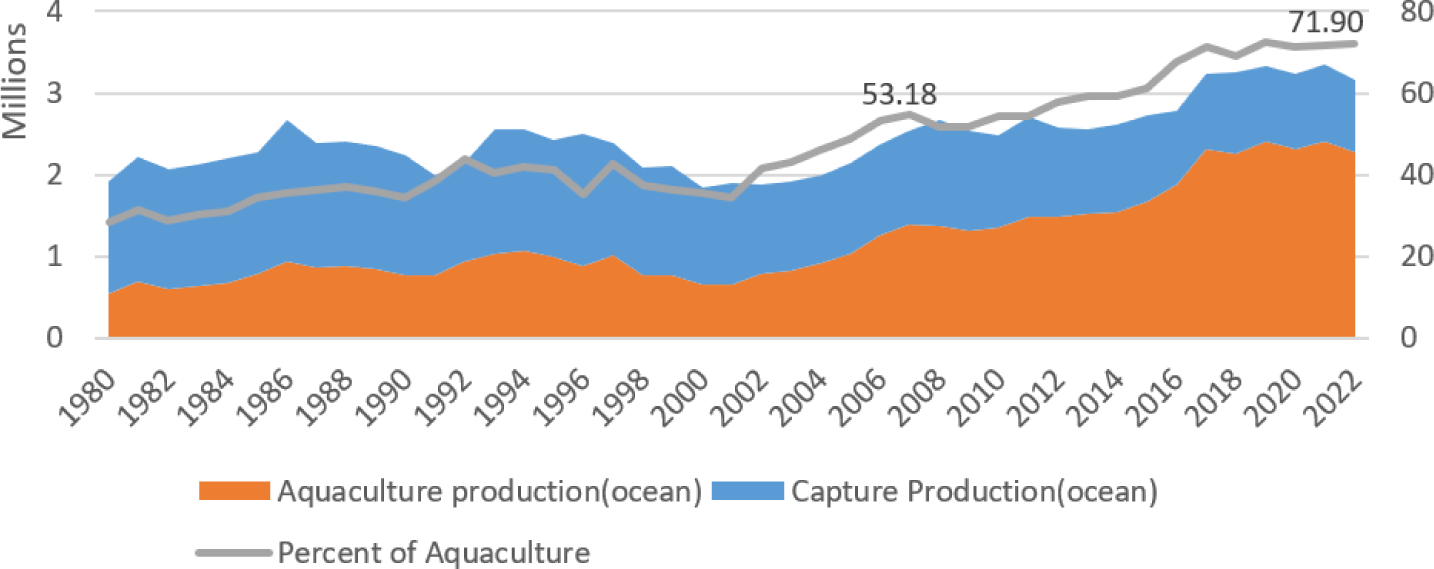
Despite these trends, capture fisheries will continue to be important. There are ecological and environmental benefits to capture fisheries that are not found in aquaculture.
First, capture fisheries can maintain ecosystem balance. Capture fisheries take place in environments where different species naturally reproduce and grow. If managed in a sustainable way, capture fisheries can avoid over-concentration on certain species and contribute to maintaining the natural species diversity of marine ecosystems.
Second, capture fisheries can reduce environmental pollution. Aquaculture can often cause problems that pollute water. For example, feed, chemicals, and antibiotics from fish farms can pollute the surrounding environment. Because capture fisheries take place in natural ecosystems, there is relatively little of these kinds of pollution.
Third, wild-caught fish may have a higher nutritional value. Some research suggests that wild-caught fish may have a higher nutritional value than farmed fish. For example, wild-caught fish may have a higher omega-3 fatty acid content and a healthier fat distribution.
Fourth, capture fisheries can contribute to a sustainable economy. When managed sustainably, capture fisheries are an important source of income for local economies and traditional fishing communities. It can provide livelihoods in many coastal and island communities.
Although capture fisheries are important, they are always vulnerable to illegal, unregulated, unreported (IUU) fishing and overfishing. Due to government support and the short-term profit motive of fishermen, capture fisheries have been catching more fish than they should. Based on FAO's assessment, the fraction of fishery stocks within biologically sustainable levels decreased to 62.3% in 2021, that is 2.3% lower than in 2019. This fraction was 90% in 1974. In contrast, the per centage of stocks fished at unsustainable levels has been increasing since the mid-1970s, from 10% in 1974 to 37.7% in 2021 (FAO, 2024c). Overfishing - fishing that causes the reduction of stock abundance to below the level that can produce Maximum Sustainable Yield (MSY) - not only causes negative impacts on biodiversity and ecosystem functioning, but also reduces fish production, which subsequently leads to negative social and economic consequences. Rebuilding overfished stocks to the biomass that enables them to deliver MSY could increase fisheries production by 16.5 million tonnes and annual rent by USD 32 billion (FAO, 2024b; Ye et al., 2013). Sustainable Development Goal (SDG) 14 (Conserve and sustainably use the oceans, seas and marine resources for sustainable development) set Target 14.4: to end overfishing by 2020. Unfortunately, world fisheries have diverged from this target, with overfishing increasing from 35.4% in 2019 to 37.7% in 2021 (FAO, 2024a).
The options for maintaining adequate fish stocks are clear. Either we increase inputs (stimulate reproduction) or reduce outputs (catch). The traditional response has been to reduce fishing intensity. This will naturally stimulate reproduction. This is the least intrusive and most effective way to reduce human interference with natural ecosystems. On the other hand, governments and fishermen can also actively intervene to promote reproduction, which means reducing environmental pollution and protecting or creating spawning grounds. Marine seeds release can also stimulate reproduction.
2. Marine Seeds Release in South Korea: Current Status and Effectiveness
Marine seeds release is a way to restore fish stocks by releasing fry or fingerling (marine seeds) raised in tanks on land into the sea. While aquaculture is compartmentalised and isolated from the outside, marine seeds release targets the commons.
As of 2023 in South Korea, a total of 69 species (53 marine species, and 16 inland species) are managed for release. In particular, in 2007, the Fisheries Resources Management Act (FRMA) made it mandatory to conduct a release effectiveness survey to review the effectiveness of the release project. In 2011, the Korea Fisheries Resources Agency (FIRA) was established to take over the management of seeds releases from the NIFS. In 2016, a marine seeds certification system was introduced to ensure more thorough management of the released varieties. In 2016, a marine seeds certification system was introduced to ensure more thorough management of the released Varieties (FIRA, 2024a).
To improve the effectiveness of marine seeds release, FRMA specifies the place and time of release, the variety, and the size of the seeds. In particular, to enhance the effectiveness of the marine seeds release programme, a consultative committee is formed, and the opinions of fishermen are taken into consideration when selecting the seeds to be released. This process often involves the selection of local specialty varieties or species that are commonly caught in the area but have become overfished. Measures are also taken to ensure genetic diversity and prevent the spread of infectious diseases. In particular, a four-year research plan has been established to investigate the effectiveness of the releases, including marking and tracking surveys, recovery rate surveys, genetic research, and economic analysis. The budget for aquatic seeds release in 2022 was 41.3 million USD.
We will look at the effectiveness of marine seeds release by focusing on the varieties that have global statistics among the projects that are released as the main marine species in South Korea. To analyse the effectiveness of marine seeds release, South Korea uses recapture rates of fish stocks caught in marine seeds release areas. To identify the released marine seeds, tracking is done using methods such as building a genetic1 database of the released individuals or tagging them.
Among a total of 69 species of aquatic seeds release projects, I will select 10 species for which the characteristics of climate change and marine seeds can be well understood, and examine their production trends, seeds release effects, etc. Among a total of 69 species of aquatic seeds release projects, I will select 10 species for which the characteristics of climate change and marine seeds can be well understood, and examine their production trends, seeds release effects, etc (NIFS, 2024a ; 2024b). The species selected for this purpose are pacific cod, bastard halibut, stone flounder, fleshy prawn, swimming crab, blackhead seabream2, black rockfish3, Alaska pollock, spotted sea bass, and barred knifejaw. For the convenience of discussion, detailed statistics on the production and seed release of each species are attached in Appendix separately and omitted from the main text, and only general trends are examined. The current status and trends of production and seeds release for these species are schematically shown in Figures 4 to 13. For stone flounder, spotted sea bass, and barred knifejaw, for which global production statistics are unknown, only Korean statistics were used. The current status and trends of production and seeds release for these species are schematically shown in Figures 4 to 13 (FIRA, 2024b).
The effects of marine seeds release vary for each species. Although no statistical method was used here, the seeds release that can clearly estimate its effectiveness on the graph when compared to the global production is swimming crab. Blackhead seabream shows a certain degree of correlation that the seeds release may have an effect. In the case of barred knifejaw, it is difficult to compare because there are no global production statistics, but the correlation between seeds release and domestic statistics is clearly visible. For other seeds, it is difficult to observe the effectiveness on the graph.
However, looking at the recapture rate performed by FIRA in the seeds release areas, the figures range from 3.2% to 63.4% (Table 1). Pacific cod is 3.2%, bastard halibut is 63.4%, stone flounder is 13.0%, fleshy prawn is 23%, swimming crab is 4.8%, blackhead seabream is 31.6%, black rockfish is 32.2%, spotted sea bass is 49.2%, and barred knifejaw is 13.2%.
| Fish species | Habitat water temperature4 | Migration characteristics | Recapture rate (%) | B/C |
|---|---|---|---|---|
|
Pacific cod (Gadus macrocephalus) |
Cold/temperate (0.8°C–14°C) |
Wide-area migratory (300 to 500 km) |
3.2 | 2.62 |
|
Bastard halibut (Olive flounder, Paralichthys olivaceus) |
Temperate/warm (8.6°C–25°C) |
Demersal sedentary | 63.4 | 5.56 |
|
Stone flounder (Platichthys bicoloratus) |
- | Demersal sedentary | 13 | 1.27 |
|
Fleshy prawn (Fenneropenaeus chinensis) |
Warm | Migratory | 23 | 3.57 |
|
Swimming crab (Portunus trituberculatus) |
4°C–30°C | Migratory | 4.8 | 4.21 |
|
Blackhead seabream (Acanthopagrus schlegelii) |
Temperate/warm (13.1°C–25.4°C) |
Sedentary | 31.6 | 3.47 |
|
Black rockfish (Sebastes schlegelii) |
Temperate/warm (8°C–21.3°C) |
Migratory | 32.2 | 2.01 |
|
Alaska pollock (Walleye pollock, Gadus chalcogrammus) |
Cold (2°C–10°C) |
Wide-area Migratory | - | - |
|
Spotted sea bass (Lateolabrax maculatus) |
Temperate/warm (12.7°C–26.3°C) |
Coastal migratory | 49.2 | 1.95 |
|
Barred knifejaw (Oplegnathus fasciatus) |
Temperate/warm (16.1°C–25.2°C) |
Coastal sedentary | 13.2 | 1.05 |
| Haliotis discus | - | Sedentary | 55.0 | 2.59 |
| Apostichopus japonicus | - | Sedentary | 43.1 | 1.84 |
In addition, B/C analysis was performed to analyse the feasibility of seeds release for each of these species5, and the results were 1.05 to 5.56, indicating that all are economically feasible.
The most important thing in marine seeds release projects is that the released marine seeds grow to adulthood and contribute to the reproduction of the stock. In the end, the effectiveness can only be seen in the recapture rate. Of course, if we also consider the B/C, we can check the efficiency of the project and decide whether to continue the project in the future.
Given the unique nature of the ocean environment, a recapture rate of 20% or more may be considered a very successful outcome. In the Table 1, the species with a recapture rate of more than 20% are bastard halibut, fleshy prawn, blackhead seabream, black rockfish, spotted sea bass, Haliotis discus and Apostichopus japonicus.
Species with high recapture rates are predominantly temperate and/or warm-water species. In terms of migration characteristics, they are either (demersal) sedentary or local migratory species. In particular, all species with recapture rates above 50% are sedentary species. It can be concluded that it is the migration characteristics that have more influence on the recapture rate than the water temperature.
On the other hand, species that are cold-water species and have a wide range of migration can be considered to have significantly lower recapture rates. In particular, the recapture rate for Pacific cod was 3.2%, and for Alaska pollock it was difficult to determine the recapture rate. Of course, despite the low recapture rate for Pacific cod, the B/C was 2.62, which is a positive aspect that it is economically beneficial to continue the marine seeds release.
Rising ocean temperatures do not necessarily translate into an increase in warm-water fish species (NIFS, 2023). Fish and other aquatic organisms depend on many variables, including habitat, spawning grounds, prey, salinity, and oxygen levels, to affect their reproduction and migration, not just ocean temperature.
However, there are factors that seem to affect the effectiveness of marine seeds release in the context of climate change. In particular, the environment of the sea must be favourable for the particular species and the range of the species must be not as wide as possible. For cold-water, wide-ranging fish species such as Alaska pollock, it is difficult to see the effects of seeds release within a short period of time.
If similar marine seeds release projects are pursued in the future by South Korea or other countries, it would be advantageous to assess the suitability of the respective habitats for the specific species in advance and, if possible, to select species with narrower migratory ranges. In this regard, specific release procedures and preliminary impact studies in accordance with the FRMA will help to improve the effectiveness of the project.
Finally, there are limitations to this analysis. The effectiveness of marine seed release was mainly based on the recapture rate and B/C analysis results. However, the factors affecting the effectiveness of marine seed release depend on many variables, including habitat, spawning grounds, prey, salinity, and oxygen levels, as mentioned above. This analysis has limitations in that it does not take these factors into account. These limitations should be supplemented in future studies.
3. Conclusion
As the ocean environment changes, the species of fish caught in South Korean Sea are also changing. As sea temperatures rise, the catch of some warm-water fish species has been steadily increasing, but this is not the case for all warm-water fish species.
One way to make fishing more sustainable is to release marine seeds. And what is even more important after discharge is to manage them in an appropriate way. Releasing marine seeds can promote the regeneration of marine ecosystems. Marine seeds release can be an important policy tool to overcome the difficulties of capture fisheries by leveraging advanced aquaculture technologies and can serve as a bridge to connect the strengths of aquaculture and capture fisheries. In other words, the marine seeds release is a good instrument for climate change adaptation policy that effectively combines the advantages of aquaculture and capture fisheries.
A review of South Korea's marine seeds release programme shows that mainly sedentary marine species and temperate and/or warm-water marine species are effective in Korean waters. While it is unlikely that the South Korea example can be replicated in other countries, it can at least help countries explore one alternative way to build fish stocks.

